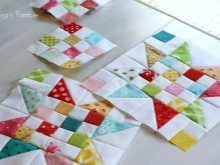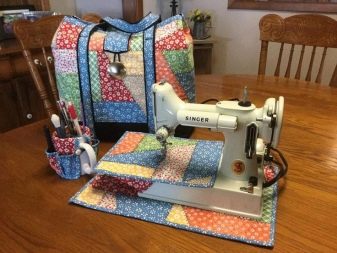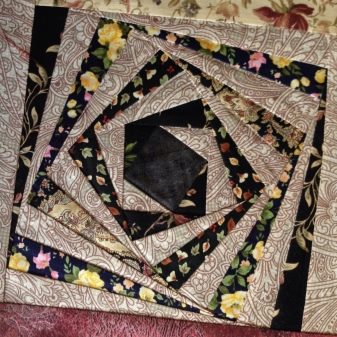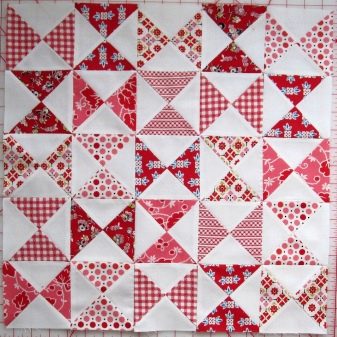The basic element of any product in patchwork technology is a block - it is found in absolutely every thing made in the patchwork style, whether it is a plaid, bedspread, pillow, pillowcase or kitchen pot holder. In our review, we will talk about how to make blocks, and what interesting techniques for their manufacture are popular with needlewomen.

Manufacturing Features
Any block in the patchwork is the main element of the future product.
In the patchwork technique in the manufacture of blankets, rugs, bags and other things, the craftswomen first make blanks for the convenience of work - these can be strips of fabric, fabric cut into squares, as well as triangles and hexagons.
These elements are stitched together in accordance with the working scheme - as a result of all the work, a block with a thematic print is obtained.
Several blocks of the same type are made in the patchwork, after which they are truncated with each other, forming a conceived thing. The appearance of needlework and its color scheme depends on the block. The block contains all the basic prints and ornaments that will be repeated several times in a large product.



Tools and materials
In order to get started, you need to collect on your desktop all the pieces of fabric that you have, sort them by shades, density and texture, only after that you can start directly to develop a working block diagram.
However, sometimes the craftswomen do the opposite - first they develop a pattern, and then workpieces are cut from an existing house or a specially purchased material for this.
In addition to fabric blanks, the following tools will also be required to create blocks:
- scissors or a sharp clerical knife;
- sewing needles and safety pins:
- chalk / pencil - they are designed to draw markings on the canvas;
- thin plastic or cardboard - necessary to form a template;
- sewing machine.


It’s not difficult to assemble such a set— you will find everything you need for the patchwork in the nearest needlework store. In addition, special kits for patchwork can always be found on sale - in addition to basic supplies and a set of tools, they also include simple block diagrams.
With everything you need at your fingertips, you can quickly and easily make stylish things in patchwork technology from elementary to real masterpieces.

The best schemes
Quick squares
Beginning needlewomen should collect patchwork blocks made of squares - they are optimal for making bedspreads, patchwork quilts, cozy blankets, tablecloths and many other bulky items. There are several basic methods for making square blocks. They are all simple to perform, with each suggesting opportunities for improvisation - that is, the choice of colors, changing the dimensions of the strips, the use of any decorative elements. All this will allow you to create creative and truly exclusive products in the style of patchwork.
The simplest technique is called “Quick Squares”. As the name implies, its basis is square blanks, which are cut from strips of matter. For the base of the block take 4 types of paintings of different colors.
To begin with, two strips are sewn together, then two more. We lay the strips on top of each other, sew them together. Then, at an angle of 45 degrees, to get the same in size and color, cut out the squares. It turns out prefabricated block squares formed from 4 types of paintings.


You can combine such blocks in any random order. 4 squares will be enough for making a pillow, and much more will be needed for a blanket: about 42 blanks are spent on an adult, about 24 are spent on a baby.

Strip to strip
In this technique, a block is formed from multi-colored strips of matter, at the same time, their placement and tint combination may vary at the discretion of the craftswoman. Basically, this style is used to create large patchwork rugs or rugs in the form of zigzag-laid parquet boards. However, the connection of individual blocks in the form of corners, rhombuses, and also in the form of a ladder is no less popular.


"Log hut"
This patchwork technique also uses stripes - they are collected near one square in the center and are arranged relative to it in a spiral. If desired, the central fragment can be slightly shifted slightly into a corner - in this case, the print will come out completely different.


Magic triangles
In the patchwork, blocks made up of blanks in the form of triangles are widespread. The similar form is convenient in work, since both the most ordinary squares and more complex stellar elements can be formed from blanks. If you take isosceles triangles, stitching them on the short side, you can form a print of multi-colored stripes. And if you grind together the long sides, you will get colored squares. Blocks of triangles received such designations as “Star”, “Pineapple” and “Diamond”.


Patchwork Corners
A characteristic feature of blocks in this style is that corners do not need to be cut with scissors - they are simply folded from squares or strips of fabric. The resulting blanks are sewn into long strips, and then a large bulk product is sewn from them.

Chess
Everything is simple here. Blocks consist of small squares of light and dark colors, which are laid out in a checkerboard pattern. If desired, the square can be turned upside down - then we get a “chessboard” made of rhombuses.


"Lyapochikha."
This is a very original technique.For the design of such blocks, multi-colored strips of raw material are attached to the base, creating a large three-dimensional canvas. Usually, any knitted items, for example, T-shirts, are used. It is advisable that the canvas, which was taken as the basis, not showered very much.

"Hourglass"
Another creative but easy-to-use technique. To make such a block, 4 squares are made, then 4 more, they are folded with the front sides and stitched around the perimeter. The resulting square is cut in a diagonal direction and 4 ready-made hourglass-based modules are formed.


Recommendations
If you are just taking your first steps in the style of patchwork, then it is worth using some recommendations of experienced craftswomen.
Start with squares. These are the simplest blocks that can only be formed from tissue fragments - they are very easy to stitch. Leave more and more complex geometric shapes for the future - they will require dexterity, because it is much more difficult to sew blanks together without distortions.
If you make any mistake, you will have to open the seam already made, and start work again.
Take large rags. The smaller the dimensions of the fabric blanks, the more work you will have to do. Accordingly, this will increase the number of errors, and in addition, you will quickly get tired of such a job, and it is possible that you simply drop your business halfway. If we take as a basis large flaps of fabric, then the first product will take very little time.

Do not pursue originality. For beginners, it is best to first copy the work of other masters. First, it’s important to “get your hand in hand”, creating interior items for ready-made step-by-step master classes. And with time, each needlewoman develops her own individual style. If you are disgusted by the idea of completely copying products of another master - simply change the color scheme of the fabric.
Learn to combine shades. Some Internet services will help you with this, where you can always choose the optimal tint palette so that the colors blend well with each other.
Assembling blocks is the main stage of any patchwork sewing, and having mastered this simple technique, you will be able to please yourself and your household with stylish and cozy decor items that emphasize the unique style of your home.
The technique of fast blocks is presented in the video.










